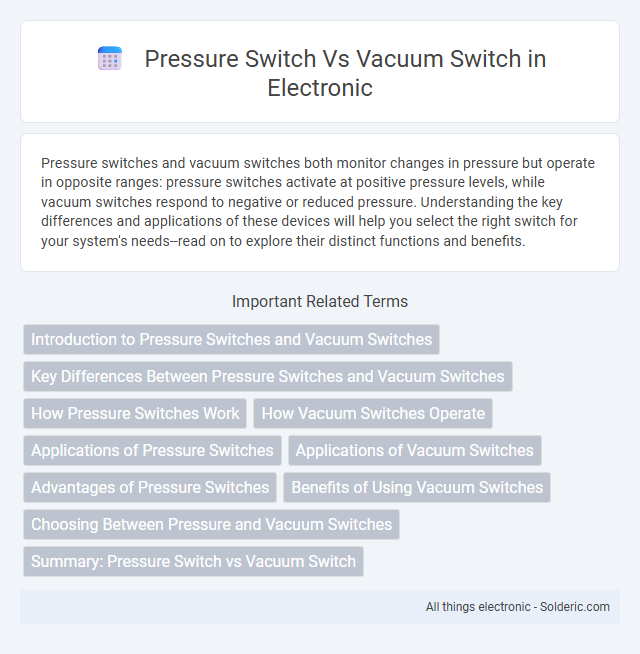Pressure switches and vacuum switches both monitor changes in pressure but operate in opposite ranges: pressure switches activate at positive pressure levels, while vacuum switches respond to negative or reduced pressure. Understanding the key differences and applications of these devices will help you select the right switch for your system's needs--read on to explore their distinct functions and benefits.
Comparison Table
| Feature | Pressure Switch | Vacuum Switch |
|---|---|---|
| Function | Monitors and controls pressure levels in fluids or gases. | Monitors and controls vacuum or negative pressure levels. |
| Pressure Range | Positive pressure, typically 0 psi and above. | Negative pressure, below atmospheric pressure. |
| Application | Hydraulic systems, compressors, pumps, HVAC. | Vacuum pumps, vacuum packaging, medical devices. |
| Sensing Mechanism | Diaphragm or Bourdon tube reacting to increase in pressure. | Diaphragm or bellows responding to vacuum levels. |
| Switch Activation | Activates at preset high or low pressure thresholds. | Activates at preset vacuum level thresholds. |
| Output | Electrical signal to control circuits or alarms. | Electrical signal to control systems or safety alarms. |
| Common Materials | Stainless steel, brass, plastic housings. | Stainless steel, brass, elastomer diaphragms. |
| Typical Industries | Manufacturing, oil & gas, automotive, HVAC. | Pharmaceutical, food processing, medical, aerospace. |
Introduction to Pressure Switches and Vacuum Switches
Pressure switches and vacuum switches are critical components in industrial automation, designed to monitor and control fluid pressure and vacuum levels within systems. Pressure switches detect changes in pressure and trigger electrical contacts to maintain safe operation, while vacuum switches respond to negative pressure or suction. Understanding the function of each switch type ensures your system operates efficiently and prevents potential damage caused by pressure fluctuations or vacuum loss.
Key Differences Between Pressure Switches and Vacuum Switches
Pressure switches monitor and control positive pressure levels in systems by activating or deactivating electrical circuits when a set pressure point is reached, essential for applications like HVAC and hydraulic systems. Vacuum switches, on the other hand, detect and respond to negative pressure or vacuum conditions, often used in industrial processes to ensure proper vacuum levels are maintained. Understanding your system's requirements helps determine whether a pressure switch or vacuum switch offers the optimal control solution for safety and efficiency.
How Pressure Switches Work
Pressure switches operate by detecting changes in fluid or gas pressure within a system, triggering an electrical contact at a predetermined set point. The internal sensing element, such as a diaphragm, piston, or bellows, moves in response to pressure variation, activating or deactivating the switch circuit. These devices are essential for maintaining pressure levels and protecting equipment in HVAC, industrial automation, and hydraulic systems.
How Vacuum Switches Operate
Vacuum switches operate by detecting changes in pressure below atmospheric levels, triggering electrical contacts when a preset vacuum threshold is reached. These devices utilize a diaphragm or bellows that moves in response to varying vacuum pressure, converting mechanical motion into an electrical signal. Your system can rely on vacuum switches for precise control in applications such as HVAC, industrial processes, and automotive systems where monitoring negative pressure is critical.
Applications of Pressure Switches
Pressure switches are widely used in HVAC systems, industrial machinery, and water pumps to monitor and control fluid pressure, ensuring system safety and efficiency. These switches detect pressure changes and trigger electrical contacts to activate alarms or control devices, preventing equipment damage or hazardous conditions. Your equipment relies on pressure switches for real-time pressure regulation in pneumatic and hydraulic systems, enhancing operational reliability.
Applications of Vacuum Switches
Vacuum switches are commonly used in HVAC systems, vacuum pumps, and industrial equipment to monitor and control low-pressure environments. These switches ensure safety and efficiency by detecting the presence or loss of vacuum, triggering alarms, or activating control mechanisms. Your system's reliability improves by integrating vacuum switches for precise pressure management in applications such as medical devices and refrigeration units.
Advantages of Pressure Switches
Pressure switches offer precise control in monitoring fluid or gas pressure within various industrial systems, ensuring safety and efficiency by triggering alerts or actions at preset pressure levels. Their robust design provides durability and reliability in high-pressure environments, reducing maintenance costs and system downtime. Compared to vacuum switches, pressure switches typically present faster response times and greater compatibility with high-pressure applications, making them essential for hydraulic, pneumatic, and HVAC systems.
Benefits of Using Vacuum Switches
Vacuum switches offer precise control and reliable operation in low-pressure environments, making them essential for applications requiring accurate vacuum monitoring. Their ability to detect changes in negative pressure ensures safety and efficiency in HVAC systems, medical devices, and industrial processes. You benefit from enhanced system protection and reduced maintenance costs by using vacuum switches tailored to sensitive pressure conditions.
Choosing Between Pressure and Vacuum Switches
Choosing between pressure switches and vacuum switches depends on the specific application's required sensing range and medium pressure conditions. Pressure switches are ideal for detecting and controlling positive pressure levels in hydraulic or pneumatic systems, while vacuum switches are specialized for low-pressure environments, monitoring negative pressure or suction conditions. Selecting the right switch involves assessing system pressure parameters, compatibility with the fluid or gas, and the desired response sensitivity.
Summary: Pressure Switch vs Vacuum Switch
Pressure switches and vacuum switches are essential components for monitoring different types of pressure within systems, with pressure switches activating at preset positive pressure levels and vacuum switches triggering at negative pressure or vacuum thresholds. Both devices utilize similar mechanical or electronic sensing mechanisms but serve distinct roles in applications such as HVAC, industrial processes, and safety controls. Selecting between a pressure switch and a vacuum switch depends on whether the system operates above atmospheric pressure or under vacuum conditions, ensuring accurate and reliable pressure monitoring.
pressure switch vs vacuum switch Infographic

 solderic.com
solderic.com